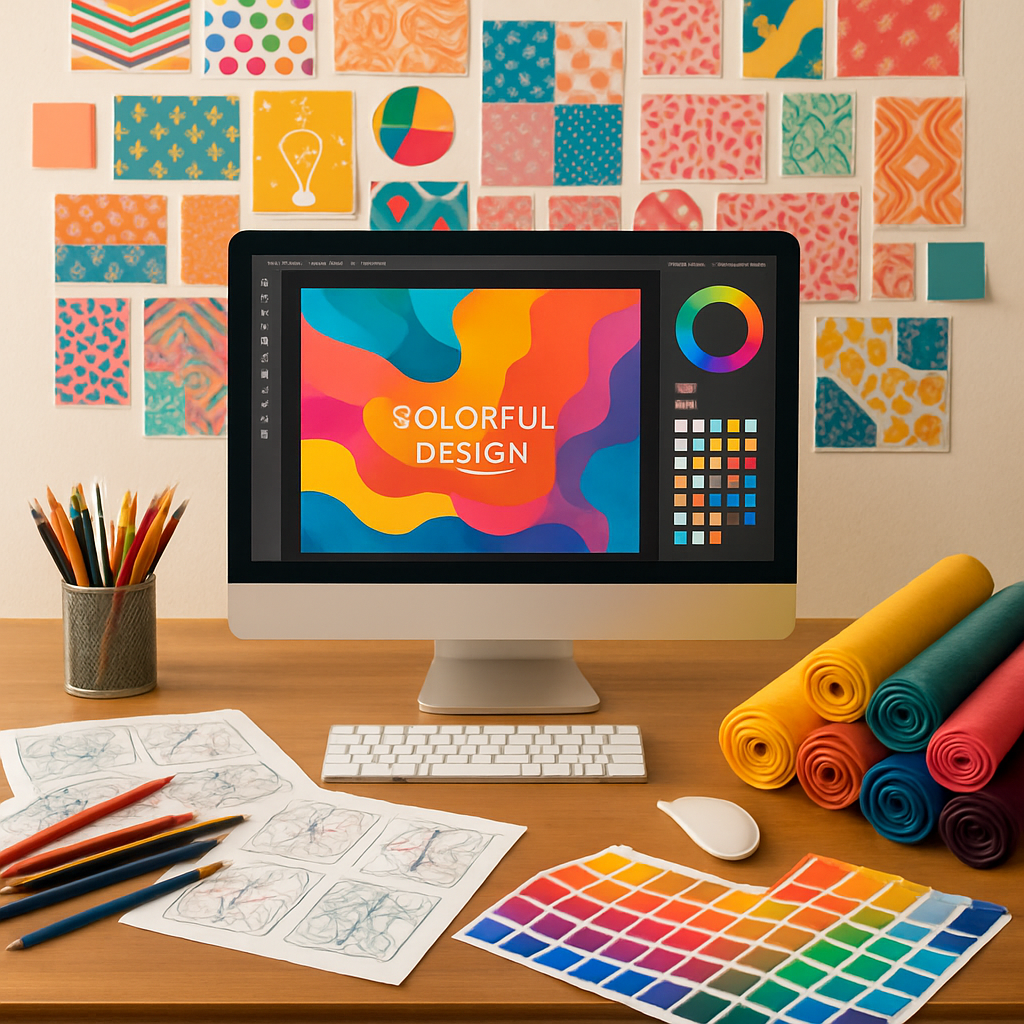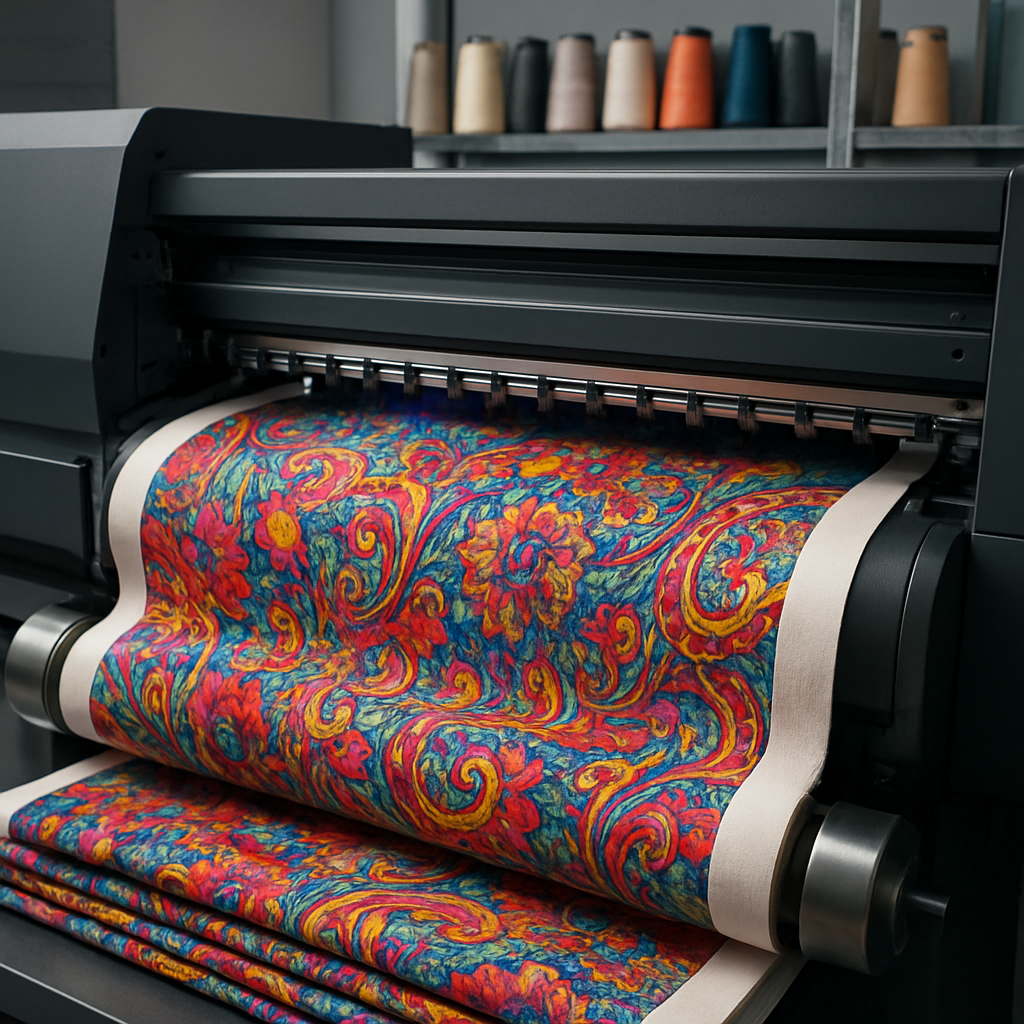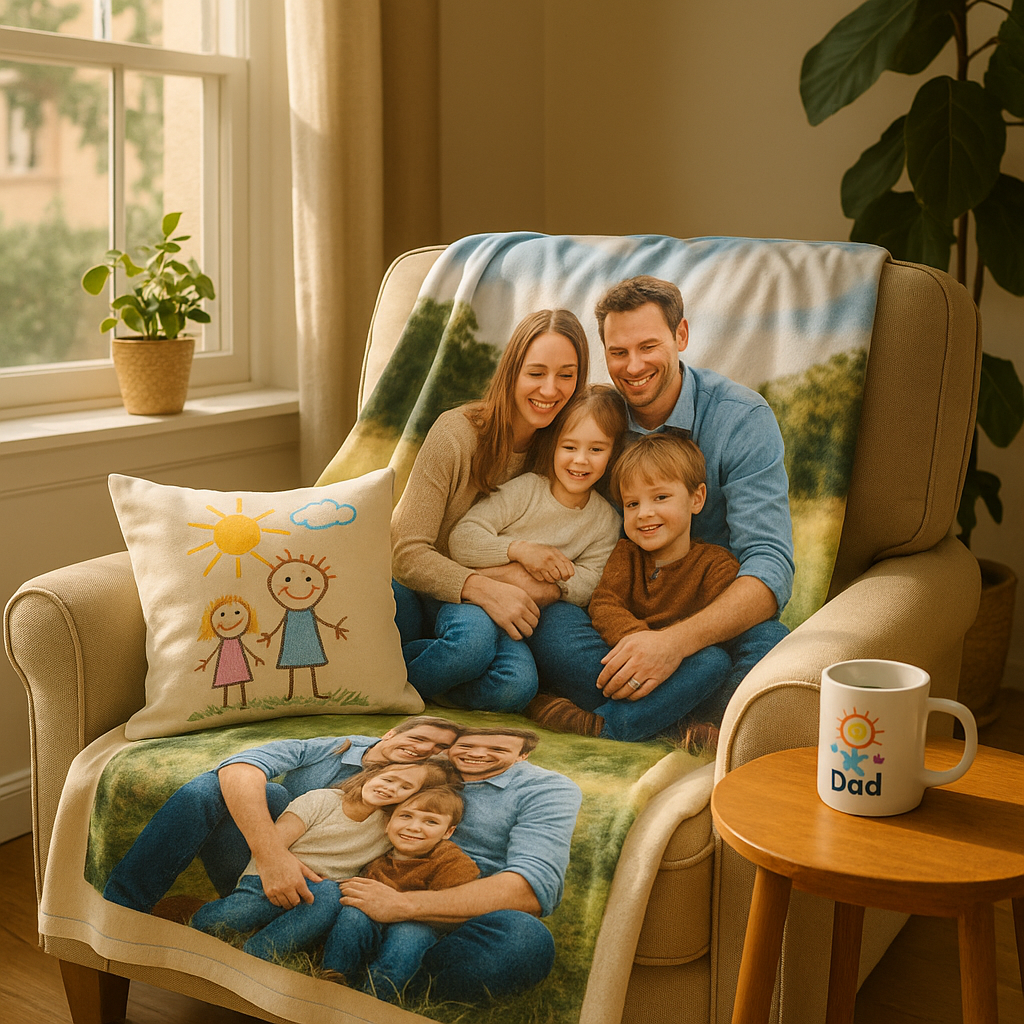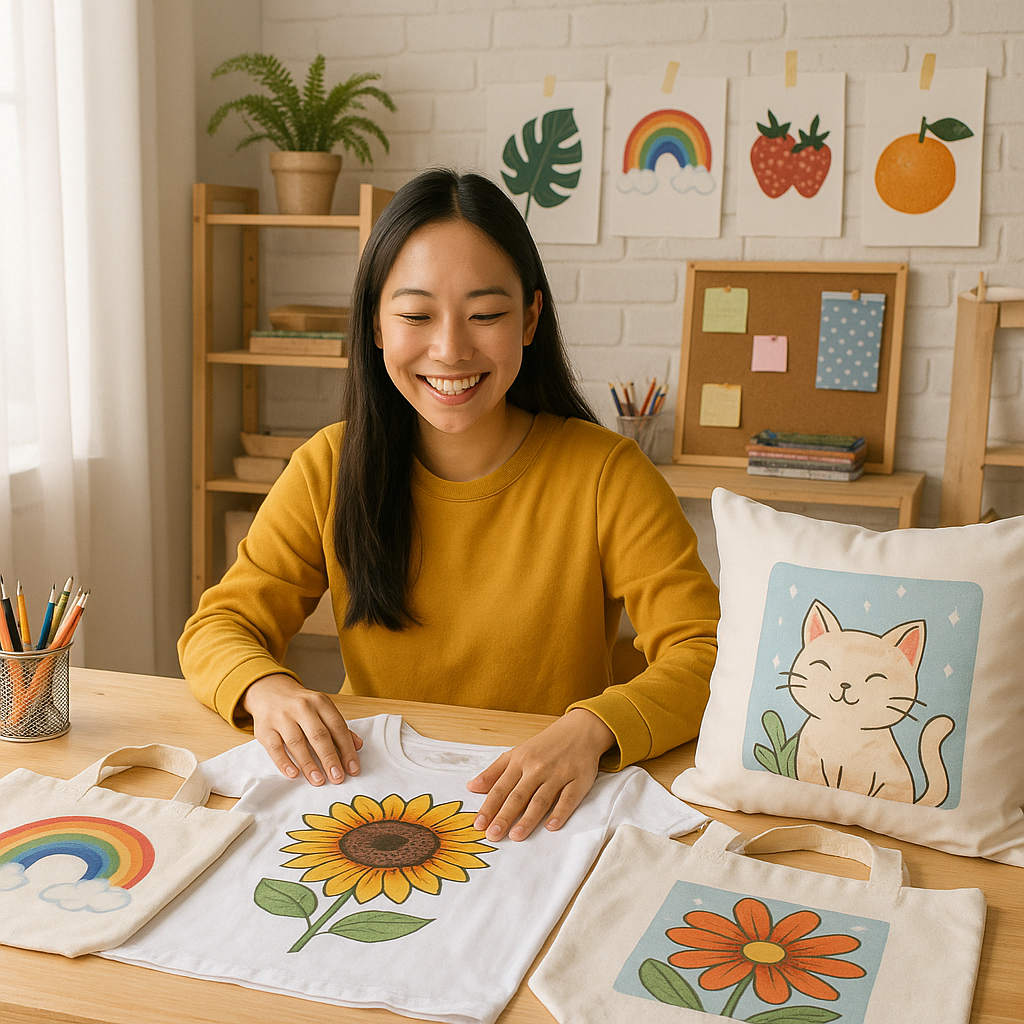
Custom Textile Printing: How Your Ideas Become Wearable Art
Share
In a world where mass-produced items dominate store shelves, there's something magical about wearing or displaying something uniquely yours. Custom textile printing bridges the gap between imagination and reality, transforming personal ideas, cherished memories, and original artwork into tangible, wearable expressions of individuality. In a world of mass-produced merchandise, personalization stands as the ultimate expression of thoughtfulness, allowing us to create pieces that speak volumes about who we are and what matters to us.
This creative journey takes your concepts from digital files or hand-drawn sketches and brings them to life on fabric—whether it's a t-shirt featuring your own artwork, custom pillows showcasing family photos, or personalized accessories that make statements about your unique style. Throughout this article, you'll discover the fascinating process behind custom textile printing, explore various printing techniques, understand its applications for self-expression and gifting, and learn practical tips for creating your own wearable art.
From imagination to fabric: the process of custom textile printing
The transformation of an idea into wearable art follows a fascinating journey that combines creativity with technical precision. Understanding this process helps you appreciate the craftsmanship behind custom printed textiles and prepares you for creating your own personalized pieces.
Conceptualization and design preparation
Every custom textile project begins with inspiration. Whether it's an original illustration, a photograph, or a pattern concept, this initial idea forms the foundation. Designers then translate this vision into a digital format, typically using design software like Adobe Illustrator or Photoshop.
During this stage, considerations about color, scale, and placement are crucial—what looks perfect on screen might need adjustments to work well on fabric.
Professional designers often create repeating patterns or ensure proper resolution (typically 150-300 DPI) to maintain clarity when printed. They also consider the specific requirements of different fabrics and printing methods, as some materials handle detail better than others.
File preparation and color matching
Once the design is refined, it must be prepared for production. This involves converting colors to the appropriate color space (typically CMYK for printing), creating proper file formats (often PNG or PDF), and ensuring all elements are positioned correctly for the specific garment or item.
Color matching is particularly important in personalized clothing production. What you see on screen may differ from the final printed result due to differences between digital displays and physical printing. Professional printers often provide color swatches or samples to ensure expectations align with outcomes.
Fabric selection and preparation
The choice of fabric dramatically affects the final product. Cotton absorbs ink differently than polyester, and natural fibers may require different treatments than synthetics. Before printing, fabrics typically undergo pre-treatment processes that prepare the surface to receive and hold ink properly.
For the best custom printed fabrics, material selection must complement both the printing method and the intended use of the final product. A beach towel requires different fabric considerations than a delicate scarf or structured t-shirt.
At Monvaro, we blend creativity with quality to bring you unique, custom-made gifts that transform ordinary items into extraordinary expressions of personal connection.
Printing execution and finishing
With designs prepared and fabric ready, the actual printing begins.
Depending on the chosen method (which we'll explore in the next section), the design is transferred onto the fabric through various techniques. After printing, items typically undergo heat-setting or curing to ensure the design bonds permanently with the fabric.
The wearable art journey doesn't end with printing. Most custom textile products require additional steps: cutting fabric to patterns, sewing into final forms, adding tags, and performing quality checks to ensure colors, alignment, and construction meet standards. For apparel, this might include adding finishes like collars or cuffs, while home textiles might require hemming or backing materials.
The design-to-garment process typically takes anywhere from a few days to several weeks, depending on complexity, quantity, and customization level. For those seeking unique, creative gift options, custom pet socks transform a beloved pet's portrait into wearable art that brings smiles with every step.
Techniques and innovations in textile printing
The world of fabric printing methods has evolved dramatically over centuries, from ancient hand-block printing to today's advanced digital processes. Each technique offers distinct advantages and aesthetic qualities, making them suitable for different applications in personalized textile creation.
Traditional screen printing: the time-tested approach
Screen printing (also called silk screening) involves creating stencils (screens) for each color in a design, then pressing ink through these screens onto fabric. This method excels at producing vibrant, opaque colors with excellent durability and wash-fastness.
Advantages include:
- exceptional color vibrancy on both light and dark fabrics
- cost-effectiveness for larger production runs
- special effects capabilities (metallic, puff, glow-in-the-dark inks)
- excellent durability that withstands numerous washing cycles
However, screen printing requires separate screens for each color, making intricate multi-colored designs more labor-intensive and expensive. It's ideal for bold graphics, team uniforms, and branded merchandise where consistent reproduction matters more than intricate detail.
Digital textile printing: precision and versatility
Digital printing works similarly to home inkjet printers but on a larger scale with specialized fabric inks. This technology has revolutionized custom textile creation by enabling photo-realistic reproduction, unlimited colors, and economical short runs.
Digital methods include:
- Direct-to-Garment (DTG): Prints directly onto finished garments, perfect for one-offs and detailed designs
- Dye-sublimation: Uses heat to transfer dyes into polyester fabrics, creating permanent, full-bleed images
- Direct-to-Film (DTF): A newer hybrid approach offering versatility across fabric types
When comparing screen printing vs digital printing, the key differences involve setup costs, color capabilities, and production volumes. Screen printing requires higher initial setup but becomes more economical with larger quantities, while digital printing excels at small batches and intricate designs without setup fees.
Sustainable textile printing approaches
Environmental consciousness has driven innovation in eco-friendly printing methods. Sustainable textile printing focuses on reducing water consumption, eliminating harmful chemicals, and decreasing waste.
Key developments include:
- water-based and low-impact reactive dyes that reduce chemical usage
- pigment inks that require less water in production
- digital processes that minimize fabric waste
- recycled and organic base materials
- closed-loop water systems in production facilities
These approaches satisfy growing consumer demand for environmentally responsible products without sacrificing quality or design possibilities. Manufacturers increasingly highlight their sustainable practices as selling points for eco-conscious shoppers.
Emerging technologies and specialty techniques
Innovation continues to expand creative possibilities in custom fabric production. Some notable advancements include:
Reactive printing: Creates exceptionally soft results that become part of the fabric rather than sitting on top
Resist dyeing techniques: Modern takes on traditional methods like batik and tie-dye for artistic effects
Laser etching: Uses lasers to create subtle patterns or texture variations on fabric surfaces
3D printing on textiles: Experimental approaches adding dimensional elements to fabric
These diverse fabric printing methods give creators tremendous flexibility in achieving different aesthetic and functional goals, from mass-produced commercial applications to limited-edition artistic pieces. The right technique depends on factors including design complexity, production volume, fabric type, and intended use.
Making your mark: personalization, artistry, and gift giving
Custom textile printing transcends mere decoration—it transforms ordinary items into vehicles for personal expression, emotional connection, and meaningful communication. This creative medium offers powerful ways to stand out in our increasingly standardized world.
Personal expression through wearable art
Custom printed apparel allows individuals to showcase their personalities, interests, and creativity in uniquely personal ways. From subtle artistic touches to bold statements, personalized clothing creates authentic self-expression opportunities impossible with off-the-rack items.
Artists and designers increasingly use textile printing to extend their creative vision beyond traditional media. Illustrators turn popular designs into limited-edition apparel collections. Photographers transform compelling images into wearable art pieces. Even musicians and bands create merchandise featuring album artwork or lyrics, turning fans into walking canvases for their creative expression.
For individuals, custom printing offers the chance to wear designs that perfectly reflect personal aesthetics or celebrate meaningful connections—whether that's a favorite quotation, a commemorative date, or imagery with personal significance.
The emotional impact of personalized gifts
Custom gift ideas featuring personalized textiles create profound emotional connections. Engraving Ideas: Make Every Gift Meaningful ... In a world of mass-produced merchandise, personalization stands as the ultimate expression of thoughtfulness. When we give customized items, we communicate that the recipient is worth the extra effort and consideration.
Popular personalized textile gifts include:
- family photo blankets commemorating special gatherings
- custom pillows featuring significant locations or dates
- memorial items honoring loved ones
- baby gifts with birth information or nursery themes
- anniversary presents featuring wedding vows or first dance lyrics
The creative process behind these gifts adds another dimension of value—knowing someone invested time and thought into designing something specifically for you heightens its emotional impact. Recipients often treasure these items for years, connecting them to both the giver and the occasion they represent.
Building brands and communities through custom textiles
Businesses and organizations leverage personalization to build recognition and foster belonging. Custom printed apparel creates walking advertisements while giving customers, employees, and supporters tangible connections to brands and causes they value.
Small businesses use custom textiles to:
- create branded merchandise that extends their reach
- design unique staff uniforms that enhance professional identity
- produce limited-edition items that generate excitement
- develop promotional products that keep their brand visible
Community organizations similarly use custom printed items for fundraising, team building, and identity reinforcement. From charity walk t-shirts to school spirit wear, these items transform individual supporters into visible communities united by shared values or purposes.
Preserving memories and stories
Perhaps the most powerful application of custom textile printing lies in its ability to preserve and showcase cherished memories. Family photographs, children's artwork, handwritten notes, and other treasured images can move from albums or frames onto everyday items.
This transformation allows meaningful moments to integrate into daily life rather than remaining stored away.
A blanket featuring a family tree becomes both decoration and conversation piece. A shirt displaying a child's drawing keeps that creative moment close. A pillow printed with a loved one's handwriting provides comfort and connection.
Through these applications, custom textile printing transcends simple decoration to become a medium for storytelling, connection, and meaning-making—turning everyday objects into vessels for our most important relationships and memories.
Designing your own: tips and next steps
Creating your own custom textile projects combines creative vision with technical understanding. Whether you're new to personalized fabric items or looking to improve your results, these practical guidelines will help navigate the design-to-garment process with confidence.
Design principles for successful textile prints
Effective textile designs account for both aesthetic appeal and the realities of fabric printing. When preparing artwork, consider these textile design tips:
Resolution matters: Use high-resolution images (at least 300dpi) to ensure crisp, clear results. Low-resolution images become pixelated and blurry when printed.
Consider the fabric: Different materials absorb ink differently and show detail with varying success. Smooth, tightly woven fabrics generally produce sharper images than textured or loosely woven ones.
Account for placement: Think about how designs will look when worn or displayed. Consider the curvature of the body for clothing or how pillows might be positioned on furniture.
Embrace color thoughtfully: Understand that colors may appear slightly different on fabric than on screens. When precision matters, request color swatches before finalizing designs.
Size appropriately: Ensure text is large enough to read and fine details won't be lost in printing. What works on paper doesn't always translate to fabric at the same scale.
Working with professionals: what to know
Collaborating effectively with printing professionals improves outcomes and reduces frustration. When selecting a printing service for custom printed fabrics:
Request samples: Ask to see examples of their work, ideally on fabrics similar to what you'll use.
Understand file requirements: Each printer has specific format preferences (AI, PSD, PDF, etc.) and color space requirements (RGB vs. CMYK).
Communicate clearly: Provide detailed information about your vision, including placement, size, and any critical color matching needs.
Review proofs carefully: Always check digital or physical proofs before approving full production.
Plan for production time: Custom work takes longer than off-the-shelf products—sometimes weeks rather than days.
DIY options for beginners
Not ready to work with professional printers? Several approaches make small-scale custom printing accessible to beginners:
Heat transfer paper: Print designs on special paper using a standard inkjet printer, then iron onto fabric. Best for simple designs and small quantities.
Fabric markers and paints: Create handmade designs directly on textiles for one-of-a-kind pieces.
Block printing: Carve stamps from rubber or potatoes and use fabric ink to create repeated patterns.
Print-on-demand services: Upload designs to online platforms that handle printing and shipping individual items without minimum orders.
For those seeking accessible entry points to custom textile creation, personalized pillows offer excellent canvas options that don't require specialized knowledge of garment fitting or fabric behavior.
Avoiding common pitfalls
Even experienced designers sometimes encounter challenges when creating custom textiles. Avoid these common mistakes:
Ignoring fabric color: Remember that designs print differently on colored backgrounds than on white. Dark fabrics typically require special techniques.
Overlooking washability: Consider how printing methods affect care instructions. Some techniques create more durable results than others.
Neglecting fabric characteristics: Stretchy materials distort designs when worn, while absorbent fabrics may cause colors to bleed.
Underestimating quantity needs: Order extras for items like team shirts, as reprinting small quantities later often costs proportionally more.
Rushing the process: Allow adequate time for design refinement, production, and shipping—especially for important events.
By understanding these fundamentals of the design to garment process, you'll approach custom textile projects with greater confidence and achieve more satisfying results. Whether creating personal items or developing products for others, these guidelines help navigate the exciting journey from concept to finished textile creation.
Conclusion
Custom textile printing offers a remarkable bridge between imagination and tangible expression, transforming abstract ideas into wearable, giftable, and displayable reality. This creative medium democratizes design, allowing anyone with vision to create unique items that reflect their personality, commemorate special moments, or simply bring joy.
As printing technologies continue to advance, the possibilities for personal expression through custom textiles expand with them. From sustainable practices to increasingly accessible tools, the future promises even greater opportunities for turning imagination into fabric reality.
Whether you're creating a one-of-a-kind gift, building a brand, preserving precious memories, or simply expressing your unique style, custom textile printing offers a canvas limited only by creativity. The transformation from idea to wearable art represents not just a manufacturing process but a deeply human endeavor—connecting our inner visions with the tangible world and sharing them with others in meaningful ways.
Consider exploring this creative journey yourself.
Start with a simple project that matters to you, and experience the satisfaction of seeing your ideas transformed into something you can touch, wear, share, and cherish. In our mass-produced world, there's something profoundly fulfilling about creating something that exists nowhere else—something uniquely yours.
Frequently asked questions
How does custom textile printing work?
Custom textile printing transfers your unique designs to fabrics using advanced methods like screen or digital printing for a personalized, one-of-a-kind result. The process typically involves creating or uploading a design, preparing the file for production, selecting appropriate fabric, printing using specialized equipment, and finishing the product through processes like heat-setting and sewing.
What is the best printing method for high-quality custom clothing?
Digital textile printing (DTG) offers vibrant colors and fine detail for small batches or complex images, while screen printing excels for larger runs and bold, simple designs. DTG provides excellent photographic reproduction and color gradients, while screen printing delivers unmatched durability and vibrant colors, especially on darker fabrics.
Can I use my own artwork for custom-printed fabrics?
Yes, most providers allow you to upload original artwork, photos, or patterns—just make sure your file meets their image resolution requirements. For best results, submit high-resolution files (typically 300 DPI or higher) in formats like PNG, PDF, or AI with proper color settings as specified by your printer.
Is custom textile printing environmentally friendly?
Many printers now offer sustainable textile printing options, using water-based inks and eco-friendly fabrics to minimize environmental impact. Digital printing tends to be more eco-friendly than traditional methods, using less water and producing less waste. Look for printers who specifically advertise eco-friendly practices, recycled materials, or certifications for their environmental commitments.
What are popular custom textile products to personalize?
Common choices include t-shirts, socks, pillows, tote bags, and accessories, making them ideal for personalized gifts or brand merchandise. Other popular options include blankets, hoodies, hats, aprons, and home decor items like curtains and tablecloths. The best choice depends on your intended use, budget, and the significance of the design you want to feature.
